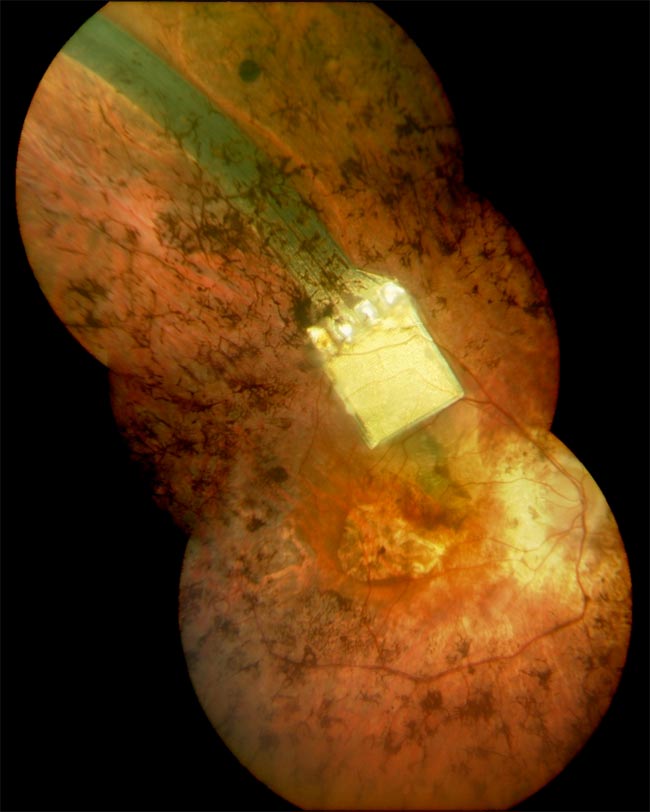Breakthrough: Microchip Implant Restores Partial Sight

For the first time, scientists have restored the ability of previously blind patients to recognize letters, fruit and other items using light-sensitive microchips implanted in the inner surface of the eye.
One patient was able to read the hands of a clock, discern seven shades of gray, find and identify tableware and combine the letters of the alphabet to form words.
The microchip is only approximately 3 millimeters by 3 millimeters in size, but is loaded with 1,500 light detectors that send a grid of electrical impulses through a patient's nerves to generate a 1,500-pixel image. The device is implanted under the retina, the inner lining of the eye unlike other implants that sit outside the retina and require users to wear an external camera. Since the chip requires a sharp image, the patients wear reading glasses. [Image of implant in eye]
The implant, a product of 15 years of research, essentially replaces degenerated rod and cone cells in the retina of patients suffering from diseases such as retinitis pigmentosa, a group of inherited diseases that afflict 1 in 4,000 people across the world and is characterized by poor night vision and slow loss of peripheral vision. A thin wire snakes from inside the eye to its edge and then under the skin to a spot behind the ear, where patients can attach a cord linked to a control box that supplies power. Patients can also use the control box to adjust the brightness and contrast of images.
In the pilot study, 11 patients received an implant, all of whom had been blind for two to 15 years due to hereditary retinal dystrophy. Five of the 11 patients were able to recognize and localize sources of light or large, whitish objects. The last three had the chip implanted in the macula, the spot in the retina that normally has the sharpest vision, and after a week were able to see shapes and objects. The final patient was able to correctly identify apples and bananas [Video], read the time from a large clock and recognize individual letters and words within two to three weeks of implantation.
"There was a time when that one patient rediscovered his hand and was just fascinated by it, moved his fingers and took them apart, turned his hand over and looked at the movement of his thumb," researcher Eberhart Zrenner, a neuro-ophthalmologist at the University of Tuebingen in Germany, told LiveScience.
"The visual results they were able to achieve were, up until now, thought to be in the realms of science fiction," said ophthalmologist Robert MacLaren at the University of Oxford in England, who will implant the chip in the first patients in the United Kingdom. "The recent work by Professor Zrenner and his team in successfully testing this electronic retinal implant in blind people is without doubt a significant advance in this technology," said MacLaren, who was not involved in Zrenner's study.
Sign up for the Live Science daily newsletter now
Get the world’s most fascinating discoveries delivered straight to your inbox.
Not all blind patients will benefit from this device, including cases where the optic nerve or brain damage is involved, or where the retina is ruined or has insufficient blood flow. Zrenner also cautioned that this work is still in progress, and they are still refining where best to implant the device and learning which patients might benefit most. "It's important not to raise false hope," he stressed. "It will be a while before there is a reliable, marketable device."
The first devices had to be removed after three months, since they used wires that could not be left inside the body indefinitely. A Europe-wide multi-center study with 25 more patients has now begun with an improved version of the implant that can be left inside permanently.
"Already I've had a patient from the Netherlands, who is going to marry his girlfriend and had never seen her before, tell me he saw her laughing," Zrenner said. The patient, he added, could tell she was laughing from her white teeth.
The scientists detailed their findings online Nov. 3 in the Proceedings of the Royal Society B.










